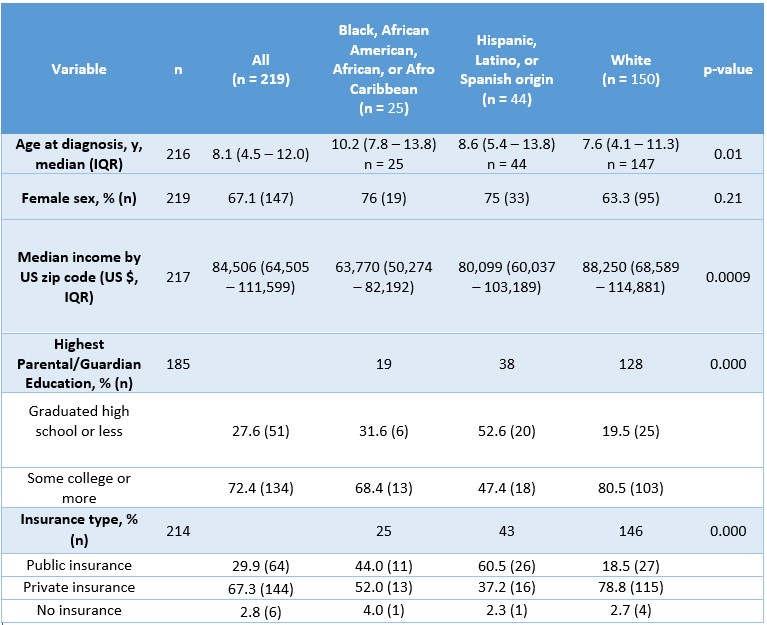Session Information
Session Type: Poster Session B
Session Time: 5:00PM-6:00PM
Background/Purpose: Previous studies in juvenile dermatomyositis (JDM) have shown that patients from minoritized ethnicities and those with lower family income are more likely to have worse clinical outcomes. Patient-reported outcome measures (PROs) are valuable indicators of disease activity but are less well-studied in JDM. This study aimed to investigate differences in clinical outcomes and PROs based on race and ethnicity at baseline enrollment, in a cohort of patients enrolled in the Childhood Arthritis and Rheumatology Research Alliance (CARRA) registry.
Methods: This was a retrospective cohort study using data from children diagnosed with JDM and enrolled into the CARRA Registry between February 2018 and November 2021, for whom data regarding race and ethnicity were available. Participants without valid US zip codes were excluded. The primary predictor was self-identified race and/or ethnicity. The primary outcome was the Patient/Parent Global Assessment Score (PGA) as a dichotomous variable of score < /= 2 (lower disease activity) or > 2 (higher disease activity). Secondary outcomes included proximal muscle weakness, elevated muscle enzymes, and physician global assessment of skin disease activity. Descriptive statistics were used to summarize each variable, and demographic and baseline disease activity measures were evaluated across racial and ethnic categories using Chi-squared, Kruskal-Wallis, and one-way ANOVA tests. Demographic variables with significant association with race and ethnicity were included in a multivariate model analyzing PGA score greater than 2 at baseline.
Results: 219 participants identified as Black (11.4%), Hispanic (20.1%), or White (68.5%). Demographic characteristics are listed in table 1. Median income by US zip code was lowest among Black participants, while White participants had the highest median income (p = 0.04) (Table 1). Black and Hispanic participants were more likely to have proximal muscle weakness (p = 0.005), elevated muscle enzymes (p = 0.03), and higher physician global assessment scores indicating worse disease activity (p = 0.03) compared to White participants (Table 2). Black participants had 3.3 times the odds of having a PGA > 2 at baseline compared to White participants (95% CI 1.2 to 9.0, p = 0.02). After adjusting for age at diagnosis, sex, income, education, and insurance status, this association was no longer statistically significant, however, those with private insurance had 74.6% lower odds of having a PGA > 2 compared to those with public insurance.
Conclusion: In JDM participants enrolled in the CARRA Registry, Black and Hispanic participants tended to have lower income and education levels. While Black participants had a higher odds of having worse PGA at baseline, this association diminished after adjusting for age at diagnosis, sex, income, education, and insurance status. Our study was limited by a smaller proportion of participants from minoritized racial and ethnic groups. More research is needed to determine how patient outcomes are influenced by social determinants of health, including income, education, and the effects of systemic racism, in order to inform future interventions to improve health disparities
 Table 1: Baseline demographic characteristics by race and ethnicity
Table 1: Baseline demographic characteristics by race and ethnicity
 Table 2: Baseline disease characteristics by race and ethnicity
Table 2: Baseline disease characteristics by race and ethnicity
 Table 3: Unadjusted logistic regression of patient/parent global assessment > 2 at baseline
Table 3: Unadjusted logistic regression of patient/parent global assessment > 2 at baseline
To cite this abstract in AMA style:
Kim S, Olveda R, Neely J. Differences in Clinical and Patient-reported Outcomes in Juvenile Dermatomyositis by Race and Ethnicity [abstract]. Arthritis Rheumatol. 2023; 75 (suppl 4). https://acrabstracts.org/abstract/differences-in-clinical-and-patient-reported-outcomes-in-juvenile-dermatomyositis-by-race-and-ethnicity-2/. Accessed .« Back to 2023 Pediatric Rheumatology Symposium
ACR Meeting Abstracts - https://acrabstracts.org/abstract/differences-in-clinical-and-patient-reported-outcomes-in-juvenile-dermatomyositis-by-race-and-ethnicity-2/
